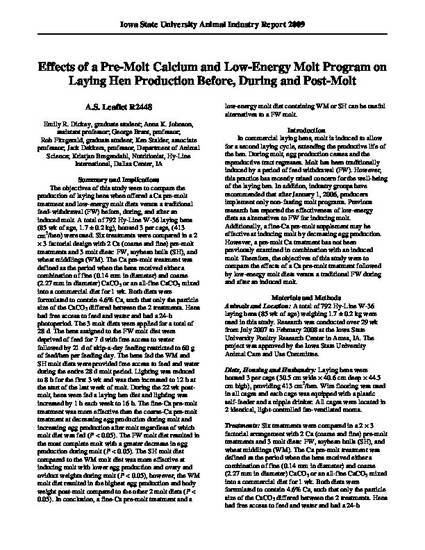
The objectives of this study were to compare the production of laying hens when offered a Ca pre-molt treatment and low-energy molt diets versus a traditional feed-withdrawal (FW) before, during, and after an induced molt. A total of 792 Hy-Line W-36 laying hens (85 wk of age, 1.7 ± 0.2 kg), housed 3 per cage, (413 cm 2 /hen) were used. Six treatments were compared in a 2 × 3 factorial design with 2 Ca (coarse and fine) pre-molt treatments and 3 molt diets: FW, soybean hulls (SH), and wheat middlings (WM). The Ca pre-molt treatment was defined as the period when the hens received either a combination of fine (0.14 mm in diameter) and coarse (2.27 mm in diameter) CaCO3 or an all-fine CaCO3 mixed into a commercial diet for 1 wk. Both diets were formulated to contain 4.6% Ca, such that only the particle size of the CaCO3 differed between the 2 treatments. Hens had free access to feed and water and had a 24-h photoperiod. The 3 molt diets were applied for a total of 28 d. The hens assigned to the FW molt diet were deprived of feed for 7 d with free access to water followed by 21 d of skip-a-day feeding restricted to 60 g of feed/hen per feeding day. The hens fed the WM and SH molt diets were provided free access to feed and water during the entire 28 d molt period. Lighting was reduced to 8 h for the first 3 wk and was then increased to 12 h at the start of the last week of molt. During the 22 wk post-molt, hens were fed a laying hen diet and lighting was increased by 1 h each week to 16 h. The fine-Ca pre-molt treatment was more effective than the coarse-Ca pre-molt treatment at decreasing egg production during molt and increasing egg production after molt regardless of which molt diet was fed (P < 0.05). The FW molt diet resulted in the most complete molt with a greater decrease in egg production during molt (P < 0.05). The SH molt diet compared to the WM molt diet was more effective at inducing molt with lower egg production and ovary and oviduct weights during molt (P < 0.05), however, the WM molt diet resulted in the highest egg production and body weight post-molt compared to the other 2 molt diets (P < 0.05). In conclusion, a fine-Ca pre-molt treatment and a low-energy molt diet containing WM or SH can be useful alternatives to a FW molt.
Available at: http://works.bepress.com/kenneth_stalder/39/
